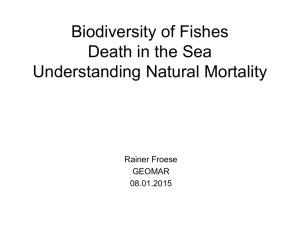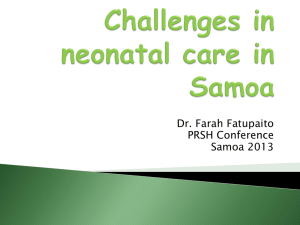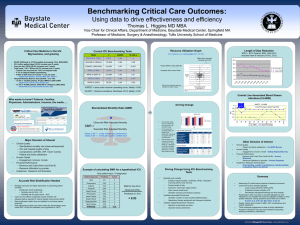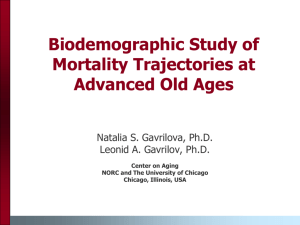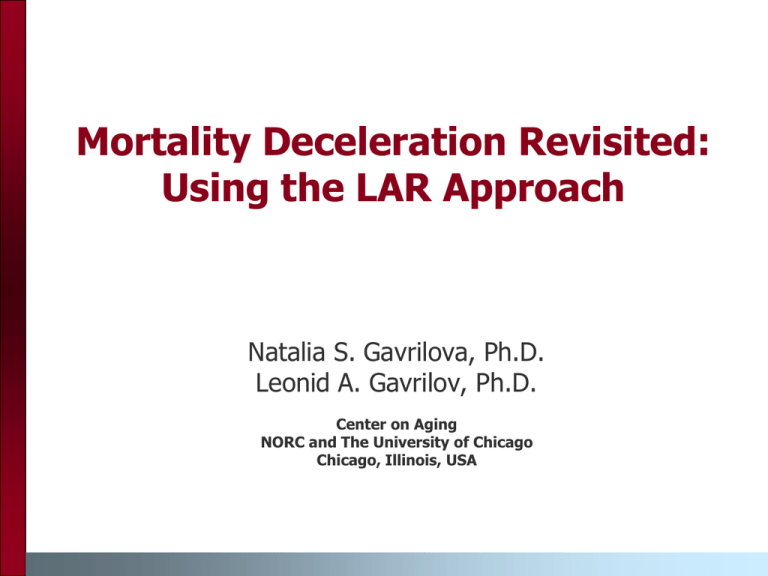
Mortality Deceleration Revisited:
Using the LAR Approach
Natalia S. Gavrilova, Ph.D.
Leonid A. Gavrilov, Ph.D.
Center on Aging
NORC and The University of Chicago
Chicago, Illinois, USA
Earlier studies suggest that
the exponential growth of
mortality with age (Gompertz
law) is followed by a period
of deceleration, with slower
rates of mortality increase.
Problems with Hazard Rate Estimation
At Extremely Old Ages
1.
Mortality deceleration in humans may
be an artifact of mixing different birth
cohorts with different mortality
(heterogeneity effect)
2.
Standard assumptions of hazard rate
estimates may be invalid when risk of
death is extremely high
3.
Ages of very old people may be highly
exaggerated
Study of mortality using Social Security
Administration Death Master File (DMF)
Data Source: DMF full file obtained from the National Technical
Information Service (NTIS). Last deaths occurred in September 2011.
Nelson-Aalen monthly estimates of hazard rates using Stata 11
Selection of competing mortality models
using DMF data
Gompertz model fits
mortality in the age
interval 85-106 years
better than the competing
Kannisto model. Based on
the study of 20 single year
1890-1899 US birth
cohorts using AIC as a
goodness-of-fit measure.
Source: Gavrilov,
Gavrilova, North American
Actuarial Journal, 2011,
15(3):432-447
Gompertz
model
Kannisto
model
The second studied dataset:
U.S. cohort death rates taken from
the Human Mortality Database
Selection of competing mortality models
using HMD US data
Gompertz model fits
mortality in the age interval
80-106 years better than
the competing Kannisto
model. Based on the study
of 22 single year 1890-1900
US birth cohorts using AIC
as a goodness-of-fit
measure.
Source: Gavrilova, Gavrilov.
Journal of Gerontology:
Biological Sciences, 2014,
DOI: 0.1093/gerona/glu009
Alternative way to study mortality
trajectories at advanced ages:
Age-specific rate of mortality change
Suggested by Horiuchi and Coale (1990), Coale
and Kisker (1990), Horiuchi and Wilmoth (1998)
and later called ‘life table aging rate (LAR)’
k(x) = d ln µ(x)/dx
Constant k(x) suggests that mortality follows the
Gompertz model.
Earlier studies found that k(x) declines in the age
interval 80-100 years suggesting mortality deceleration.
Typical result from Horiuchi and
Wilmoth paper (Demography, 1998)
Age-specific rate of mortality change
Swedish males, 1896 birth cohort
0.4
0.3
kx value
0.2
0.1
0.0
-0.1
-0.2
-0.3
60
65
70
75
80
85
90
Age, years
Flat k(x) suggests that mortality follows the Gompertz law
95
100
Slope coefficients (with p-values) for
linear regression models of k(x) on age
Country
Sex
Birth cohort
1894
Canada
France
Sweden
USA
1896
1898
slope
p-value
slope
p-value
slope
p-value
F
-0.00023
0.914
0.00004
0.984
0.00066
0.583
M
0.00112
0.778
0.00235
0.499
0.00109
0.678
F
-0.00070
0.681
-0.00179
0.169
-0.00165
0.181
M
0.00035
0.907
-0.00048
0.808
0.00207
0.369
F
0.00060
0.879
-0.00357
0.240
-0.00044
0.857
M
0.00191
0.742
-0.00253
0.635
0.00165
0.792
F
0.00016
0.884
0.00009
0.918
0.000006
0.994
M
0.00006
0.965
0.00007
0.946
0.00048
0.610
All regressions were run in the age interval 80-100 years.
Can data aggregation result in
mortality deceleration?
Age-specific 5-year cohort death rates taken from
the Human Mortality Database
Studied countries: Canada, France, Sweden,
United States
Studied birth cohorts: 1880-84, 1885-89, 1895-99
k(x) calculated in the age interval 80-100 years
k(x) calculated using one-year (age) mortality
rates
Slope coefficients (with p-values) for
linear regression models of k(x) on age
Country
Sex
Birth cohort
1885-89
Canada
France
Sweden
USA
1890-94
1895-99
slope
p-value
slope
p-value
slope
p-value
F
-0.00069
0.372
0.00015
0.851
-0.00002
0.983
M
-0.00065
0.642
0.00094
0.306
0.00022
0.850
F
-0.00273
0.047
-0.00191
0.005
-0.00165
0.002
M
-0.00082
0.515
-0.00049
0.661
-0.00047
0.412
F
-0.00036
0.749
-0.00122
0.185
-0.00210
0.122
M
-0.00234
0.309
-0.00127
0.330
-0.00089
0.696
F
-0.00030
0.654
-0.00027
0.685
0.00004
0.915
M
-0.00050
0.417
-0.00039
0.399
0.00002
0.972
All regressions were run in the age interval 80-100 years.
In previous studies mortality rates were
calculated for five-year age intervals
kx =
ln(m x )
ln(m x
5
)
5
Five-year age interval is very wide for mortality
estimation at advanced ages.
Assumption about uniform distribution of deaths in the
age interval does not work for 5-year interval
Mortality rates at advanced ages are biased downward
Simulation study of mortality
following the Gompertz law
Simulate yearly lx numbers assuming Gompertz function
for hazard rate in the entire age interval and initial
cohort size equal to 1011 individuals
Gompertz parameters are typical for the U.S. birth
cohorts: slope coefficient (alpha) = 0.08 year-1; R0=
0.0001 year-1
Numbers of survivors were calculated using formula
(Gavrilov et al., 1983):
Nx
N0
=
N x0
N0
exp
a
(e b x
b
e b x0 )
where Nx/N0 is the probability of survival to age x, i.e. the number of hypothetical cohort at
age x divided by its initial number N0. a and b (slope) are parameters of Gompertz equation
Age-specific rate of mortality change with age, kx, by
age interval for mortality calculation
Simulation study of Gompertz mortality
0.09
Taking into account
that underlying
mortality follows the
Gompertz law, the
dependence of k(x) on
age should be flat
kx value
0.08
0.07
0.06
0.05
5-year age interval
one-year age interval
0.04
70
75
80
85
90
Age, years
95
100
105
Simulation study of Gompertz mortality
hazard rate, log scale
Compare Gehan and actuarial hazard rate estimates
Gehan estimates slightly
overestimate hazard rate
because of its half-year shift
to earlier ages
1
x
x +
105
110
115
Age
120
qx )
Actuarial estimates
undeestimate mortality after
age 100
theoretical trajectory
Gehan estimate
Actuarial estimate
100
= ln(1
125
x
2
2 lx lx +
=
x lx + lx +
x
x
Conclusions
Age-specific rate of mortality change
remains flat in the age interval 80-100 years
for 24 studied single-year birth cohorts of
Canada, France, Sweden and the United
States suggesting that mortality follows the
Gompertz law
Data aggregation may increase a tendency
of mortality slow down at advanced ages
Acknowledgments
This study was made possible thanks to:
generous support from the
National Institute on Aging (R01 AG028620)
Stimulating working environment at the
Center on Aging, NORC/University of Chicago
For More Information and Updates
Please Visit Our
Scientific and Educational Website
on Human Longevity:
http://longevity-science.org
And Please Post Your Comments at
our Scientific Discussion Blog:
http://longevity-science.blogspot.com/
Which estimate of hazard rate is
the most accurate?
Simulation study comparing several existing
estimates:
Nelson-Aalen estimate available in Stata
Sacher estimate (Sacher, 1956)
Gehan (pseudo-Sacher) estimate (Gehan, 1969)
Actuarial estimate (Kimball, 1960)
Simulation study of Gompertz mortality
Compare Sacher hazard rate estimate and probability
of death in a yearly age interval
Sacher estimates practically
coincide with theoretical
mortality trajectory
hazard rate, log scale
1
x
=
1
2 x
ln
lx
x
lx +
x
Probability of death values
strongly undeestimate mortality
after age 100
theoretical trajectory
Sacher estimate
qx
0.1
90
100
110
Age
120
qx =
dx
lx
Simulation study of the Gompertz mortality
Kernel smoothing of hazard rates
.2
.4
.6
.8
Smoothed hazard estimate
80
90
100
age
110
120
Monthly Estimates of Mortality are More Accurate
Simulation assuming Gompertz law for hazard rate
Stata package uses the NelsonAalen estimate of hazard rate:
x
= H(x )
H(x
1) =
dx
nx
H(x) is a cumulative hazard
function, dx is the number of
deaths occurring at time x
and nx is the number at risk at
time x before the occurrence of
the deaths. This method is
equivalent to calculation of
probabilities of death:
qx =
dx
lx
Sacher formula for hazard rate estimation
(Sacher, 1956; 1966)
1
( ln l
x =
x
x
Hazard
rate
x
2
ln l
x +
x
2
) =
1
2 x
ln
lx - survivor function at age x; ∆x – age interval
Simplified version suggested by Gehan (1969):
µx = -ln(1-qx)
lx
x
lx +
x



